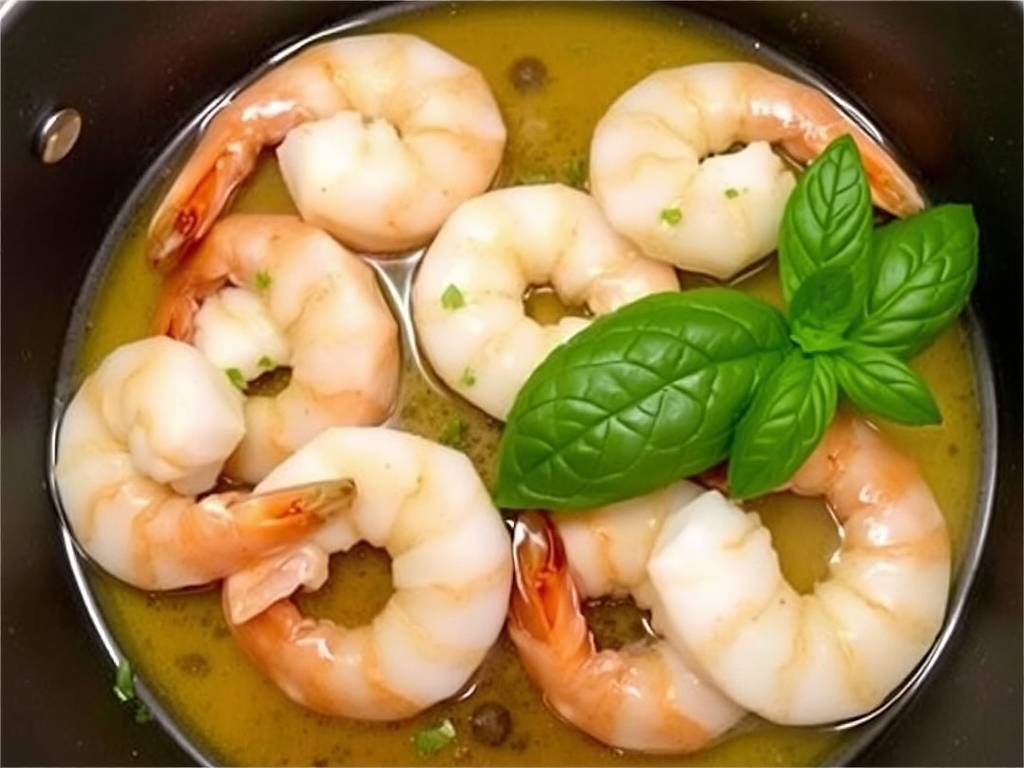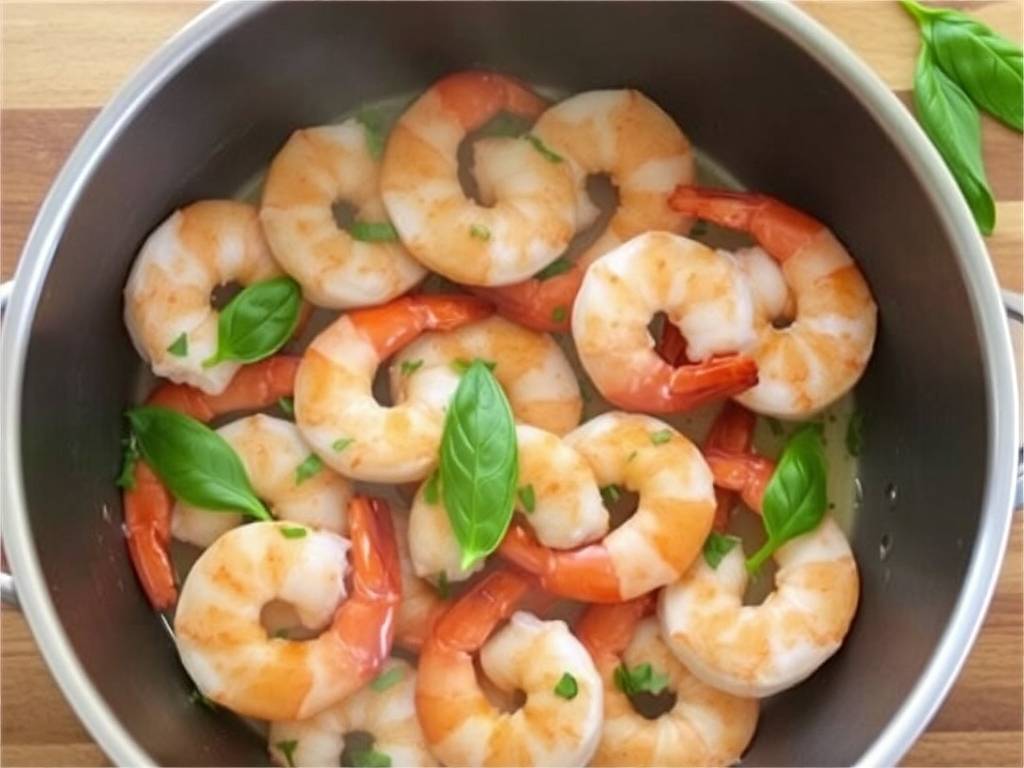A Simple Guide to Creating Restaurant-Quality Garlic Basil White Wine Shrimp at Home
There's something truly magical about the combination of plump, juicy shrimp, aromatic garlic, fragrant basil, and the subtle, acidic kick of white wine. This classic dish, often found on the menus of fine Italian restaurants, seems sophisticated, but I'm here to let you in on a little secret: it's one of the easiest, fastest, and most impressive meals you can master in your own kitchen. The beauty of this garlic basil white wine shrimp recipe lies in its simplicity and the symphony of fresh ingredients working in perfect harmony.
If you've ever been intimidated by cooking with seafood or wine, fear not. This comprehensive guide will walk you through every single step, from selecting the perfect shrimp to achieving that beautiful, glossy pan sauce that is absolutely irresistible for dipping crusty bread. We're not just making a meal; we're creating an experience. So, tie on your apron, and let's dive into the art of making the perfect easy shrimp scampi with basil and white wine.

Gathering Your Ingredients: The Foundation of Flavor
The first step to any great dish is sourcing high-quality ingredients. Because this recipe has so few components, each one truly gets a chance to shine. Using the best you can find will elevate your dish from good to extraordinary.
- The Star: The Shrimp. For the best results, I highly recommend using large, raw, shell-on shrimp. Why shell-on? The shells impart an incredible depth of flavor to the sauce as they cook. You'll be peeling them, but that little bit of extra effort is worth it. Look for shrimp labeled 16/20 or 21/25, which indicates the number per pound. Ensure they are "raw" (often grayish) and not pre-cooked (which are pink). Thaw frozen shrimp overnight in the refrigerator for the best texture.
- The Aromatic Base: Garlic and Shallots. Fresh is non-negotiable here. You'll need a generous amount of garlic—don't be shy!—finely minced. A shallot, also finely minced, adds a milder, sweeter onion flavor that complements the garlic beautifully.
- The Liquid Gold: White Wine. This is a crucial element. The rule of thumb is simple: use a dry white wine that you would enjoy drinking. A crisp Sauvignon Blanc, Pinot Grigio, or an unoaked Chardonnay works perfectly. Avoid "cooking wines" as they contain added salt and preservatives. The wine will deglaze the pan, lifting all the flavorful browned bits, and its acidity will balance the richness of the butter and shrimp.
- The Freshness: Basil and Lemon. Fresh basil is a must. We'll use it in two ways: some cooked into the sauce and a generous handful added fresh at the end to preserve its vibrant color and aroma. A fresh lemon, for both its zest and juice, will brighten the entire dish.
- The Richness: Butter and Olive Oil. We use a combination. Olive oil has a higher smoke point and forms the base for sautéing, while butter (preferably unsalted) adds a luxurious, creamy flavor and helps create a velvety sauce. Using cold butter and swirling it in at the end is a classic French technique called monter au beurre, which gives the sauce a beautiful sheen and body.
- Seasoning: Salt, Red Pepper Flakes, and Black Pepper. Kosher salt and freshly cracked black pepper are essentials. A pinch of red pepper flakes adds a subtle, background heat that wonderfully complements the other flavors without making the dish spicy.
The Step-by-Step Process: From Pan to Plate
Now for the fun part—the cooking! This entire process takes less than 20 minutes, making it a perfect quick and elegant shrimp dinner for a busy weeknight or a last-minute dinner party.
-
Prep is Key. Start by patting your thawed shrimp completely dry with paper towels. This is critical for getting a good sear instead of steaming them. Peel and devein the shrimp, but consider saving the shells if you want to make a quick shrimp stock for an even more intense flavor (simply simmer the shells in a cup of water for 10 minutes and strain). Mince your garlic and shallot, and chop your basil, keeping the smaller leaves whole for garnish. Zest and juice your lemon. Having everything measured and within arm's reach (mise en place) makes the cooking process smooth and stress-free.
-
Sear the Shrimp to Perfection. Heat a large skillet or pan (stainless steel or cast iron works great) over medium-high heat. Add a tablespoon of olive oil. Once the oil is shimmering, add the shrimp in a single layer, ensuring they aren't crowded. Season them with a pinch of salt and pepper. Cook for just 1-2 minutes per side, until they turn pink and opaque with a slight golden crust. They cook incredibly fast! Do not overcook them, or they will become rubbery. Immediately remove them from the pan and set them aside on a plate. They will finish cooking later when added back to the sauce.
-
Build the Flavorful Sauce. In the same pan, you'll see all those delicious browned bits. This is flavor gold! Reduce the heat to medium and add another drizzle of olive oil if needed. Add the shallot and cook for a minute until softened. Then, add the minced garlic and a pinch of red pepper flakes. Cook for only 30-60 seconds, stirring constantly, until fragrant. You must watch it closely, as garlic burns easily and becomes bitter.
-
Deglaze with Wine. Now, pour in your dry white wine for cooking shrimp. It will sizzle and steam dramatically—this is a good sign! Use a wooden spoon or spatula to scrape all those browned bits from the bottom of the pan. This process, called deglazing, is the secret to a deeply flavorful sauce. Let the wine simmer and reduce by about half, which will take 2-3 minutes. This cooks off the raw alcohol taste and concentrates the flavor.
-
Finish the Sauce and Bring it All Together. Once the wine has reduced, reduce the heat to low. Add the lemon juice and half of your chopped basil. Now, it's time for the butter. Add the cold butter, a few pieces at a time, swirling the pan continuously until the butter melts and emulsifies into the sauce, creating a slightly thickened, glossy coating. This is the hallmark of a professional-looking sauce. Taste the sauce and adjust the seasoning with more salt or pepper if needed.
-
The Grand Finale. Return the cooked shrimp to the pan, along with any accumulated juices. Toss them gently in the glorious sauce to warm through and coat evenly—this should take less than a minute. Turn off the heat. Stir in the lemon zest and the remaining fresh basil. The residual heat will wilt the basil perfectly, releasing its essential oils.
Serving Suggestions and Final Tips for Success
Your masterpiece is ready! Serve your garlic basil white wine shrimp immediately. It's fantastic over a bed of angel hair pasta or zucchini noodles for a low-carb option, but it's equally divine with creamy polenta, fluffy rice, or simply with a big, crusty loaf of bread to soak up every last drop of that incredible sauce. A final drizzle of high-quality extra virgin olive oil and a sprinkle of fresh basil leaves will make it look as stunning as it tastes.
To ensure your success every single time, here are a few final tips for cooking shrimp in white wine sauce:
- Don't Overcook the Shrimp: This is the most common mistake. Shrimp cook in minutes. They are done when they form a loose "C" shape. If they curl into a tight "O," they are overdone.
- Use High Heat for Searing: A hot pan is essential for getting a nice sear and preventing the shrimp from boiling in their own juices.
- Swirl, Don't Stir Vigorously: When adding the cold butter at the end, swirling the pan helps it emulsify gently into the sauce, creating a smooth texture rather than breaking.
This one-pan basil shrimp meal is more than just a recipe; it's a technique that will become a cherished part of your culinary repertoire. It’s a perfect example of how a few simple, fresh ingredients can be transformed into something truly elegant and deeply satisfying. So, the next time you're wondering what to make for a special yet effortless dinner, remember this guide. You have all the knowledge you need to create a restaurant-worthy dish right in your own kitchen. Happy cooking







发表评论